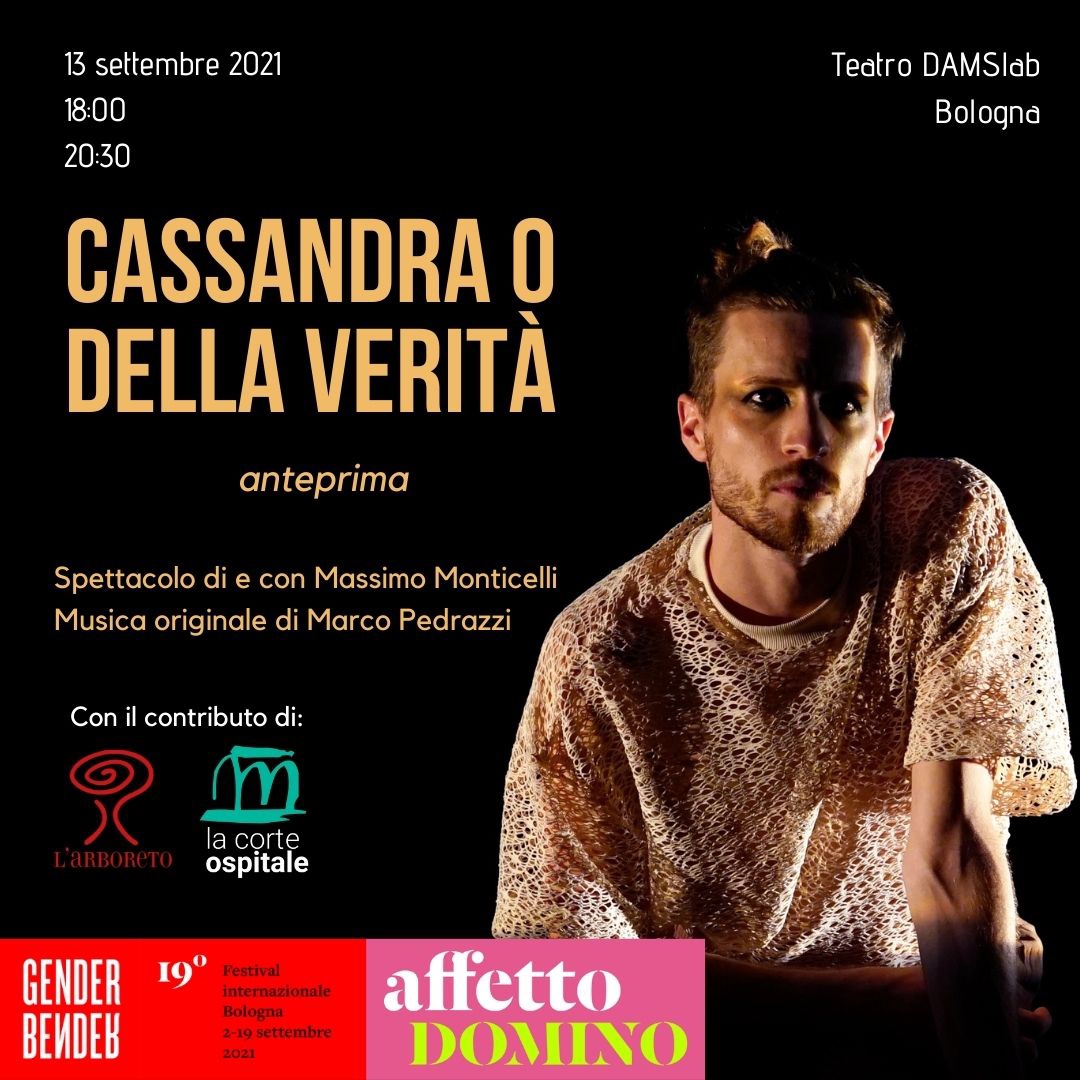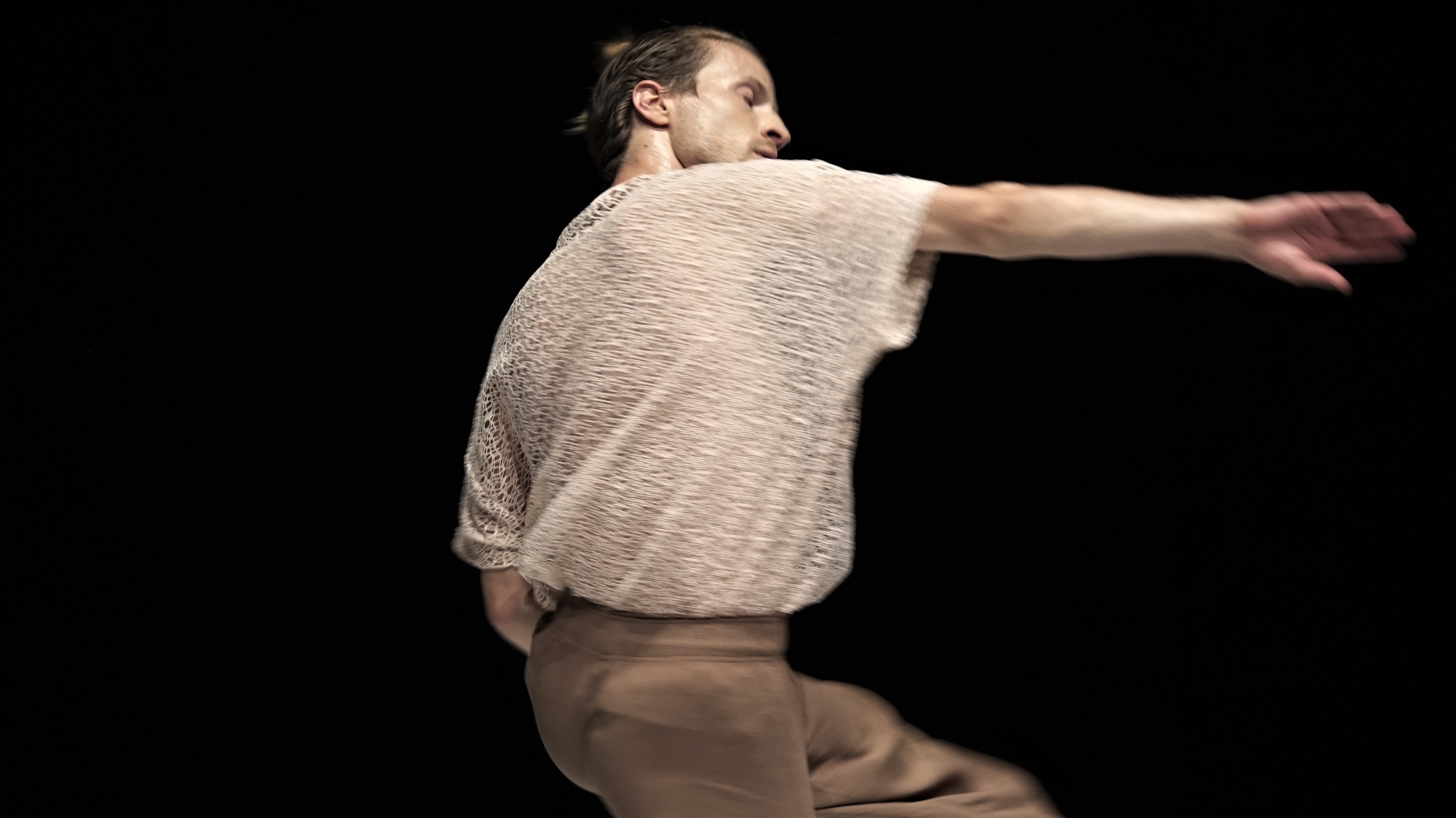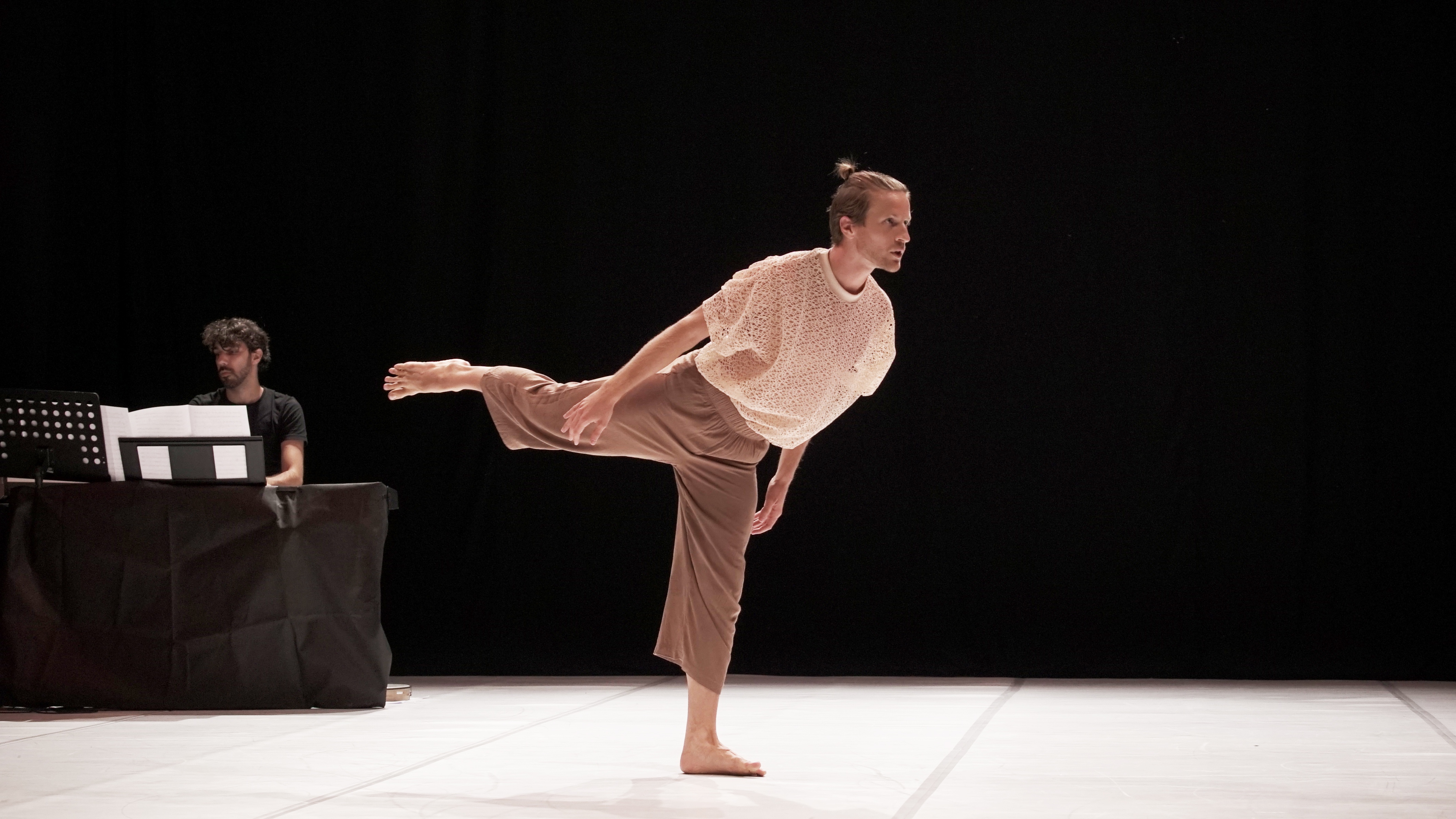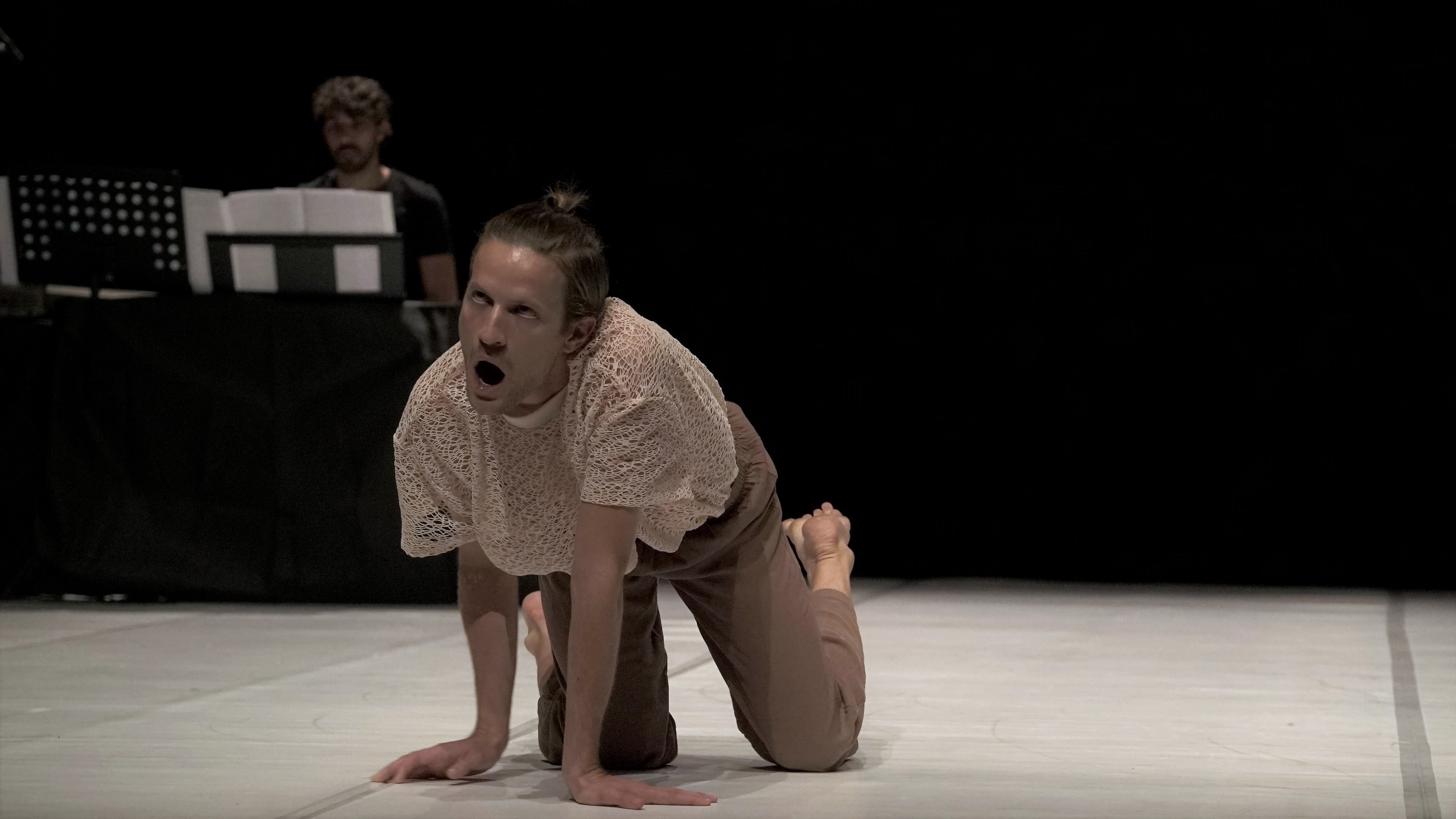Words by Giordana Patumi.
The independent dance artist talks Gender Bender festival and new work Cassandra o della Verita.
Massimo is a freelance dancer, teacher and choreographer educated in Italy, UK and France. Since 2019 he has been based in Bologna, his hometown in Italy, where he carries out his professional activities and is active in research, performance and community projects.
In 2019 he began his continuous activity with DNA dance company, for which he works as dancer and co-organiser. Along with DNA, Massimo works as tour manager and producer of DROP — Dance Research Opportunity, young company of DNA. He is also a member of the Swiss company EREM dance, where he is involved in several creations and community projects. Over the last years, Massimo has performed works by international choreographers in the UK, Italy, France, Switzerland and Austria. As part of his artistic pathway, Massimo had the opportunity to work and study with artists such as David Zambrano, Rachid Ouramdane, Rahel Vonmoos, Matthew Robinson, Ben Wright, Maxine Doyle, Joan Cleville, Noa Zuk, Theo Clinkard, Elisa Pagani, H2dance, Angelin Prejlocaj, among many others.
In 2021 Massimo was the single winner of the second edition of ERetici — Le strade dei teatri, an Italian national call for artists under the age of 28. Massimo was selected, with his project Cassandra o della Verita among 82 applications across Italy and all the arts.

Q: Hi Massimo, tell us about your background and your latest project?
Massimo: I am Massimo, an Italian freelance dancer and teacher, and now I am also trying to make some work as a choreographer. I had a quite eclectic education. My professional dance education started in the UK, where I achieved a BA in Contemporary Dance at Trinity Laban and a MA in Performance at the NSCD, as I was a dancer in VERVE19.
On top of that, I spent a few months in Paris at the National Conservatoire for my Erasmus exchange, while in Italy I graduated in Literature. I am currently completing a MA in Theatre Studies at the University of Bologna, my hometown. At the moment, I am trying to concentrate my activity in research, performance, community projects and creating my own work.
Over the last two years, I was involved as a performer and advisor in DNA, directed by choreographer Elisa Pagani, and I contributed as a core member to the Swiss company EREM dance, founded and directed by choreographer and dancer Tommy Cattin. In 2021 I was lucky enough to be selected as single winner of the second edition of ERetici — Le strade dei teatri, an Italian national call for artists under 28 promoted and supported by the Centre of Residencies Emilia-Romagna, composed by L’arboreto — Teatro Dimora and Corte Ospitale. My project Cassandra o della Verita (Cassandra or the Truth) was selected among 82 applications across all Italy and all the performing arts. Because of such a call, I was able to develop my project across four residencies, sustained by the two centres and supported by four wonderful tutors. I was also able to present a sharing in Mondaino (Rimini, Emilia Romagna) in June, to be part of the summer season of the Corte Ospitale (Reggio Emilia, Emilia Romagna) in July and, eventually, to present the preview of the work at Gender Bender International Festival in Bologna for a double show.
Q: How did Cassandra o della Verita come to life? What was the starting point?
M: The idea of Cassandra o della Verita (Cassandra or the Truth) began during the very first lockdown, March 2020, when in Italy, Covid-19 was striking hard and nobody knew anything about it. I started to notice how Truth was such a fragile concept as news and ideas were changing hour by hour. Nobody knew who or what to believe, governments were groping in the dark and it looked like Science was rejected over Fear.
I started to notice, at least in my personal vision, that those who were more eligible to be believed were the most underestimated in their voice, especially when the subjects were women. Therefore, I started to do a bit of research into these two topics, Truth and Feminism, as the more I was researching, the more my eyes could notice injustice and silencing. That is when my love for Ancient Greek culture emerged, giving me the figure that best incarnates such a condition, Cassandra, the Trojan prophetess cursed by Apollo to predict the future without ever being believed. The myth, once again, gave life to my reflections and I was completely immersed into her character and her story, so I started researching about her into Ancient Greek, Modern and Contemporary Literature. Eight months after that March, I sent my application for ERetici, and the whole journey began.
Q: What were the inspirations for the work? How did they develop over time?
M: I tried to inscribe the work into a conceptual framework that could give me solid philosophical concepts to sustain the work with, especially for what concerned feminism and philosophy of Truth, but I also wanted to use the texts that always inspired me about this extraordinary woman: Aeschylus’s Agamemnon and Euripides’s Trojan Women. However, I found endless inspiration into Christa Wolf’s Cassandra, and in the poetry of Wislawa Szymborska. Over time and while the work was developing during the residencies, I progressively chose the texts that were pointing to the direction that was interesting for me and tried to use and work with them in order to forge the foundation of the choreographic work. Eventually, thanks to a wonderful essay by Sabina Mazzoldi that I found later in the process, I was able to configure the piece from a philological perspective, while visual arts linked to Cassandra helped me to build some of the scenes in my mind and on my body.

Q: How was coordinating your first residency and solo project?
M: It was a huge first time for a lot of things. I honestly did not expect to be selected for such a big call, and when that happened, I was thrown into a beautiful but very challenging process. I suddenly had to learn how to manage a budget, how to plan months in advance, how to choose collaborators and deal with all the organisational problems linked to the artistic activity, while at the same time I had to keep researching, balance my life with this project in order to keep working and be on top of all these things during the residencies, where I wanted to be up to the responsibility of being chosen for this project. In addition, choreographing on my own body was an enormous challenge. I knew that beforehand, and I chose to work on myself to overcome several points that had challenged me in the past, and luckily there was a wonderful team to help me with that. Eventually, it was a lot of fun, I loved every single moment, and I learnt a great deal during these past months.
Q: What was the creation process? challenges/discoveries/things you didn’t expect
M: The process was wonderful, I was able to take time to explore, make mistakes, develop strategies, throw stuff away, challenge myself. I learnt a lot about what and how I need to work and what are my fears and my strengths. I learnt to not be too attached to ideas and material, to sincerely admit when things do not work and move on, to let go or persevere when one or the other is necessary. The piece has changed enormously over time, and the images I had before going into the studio do not correspond at all to the result, which is amazing to see because I could have never expected myself to follow certain directions or to make choices that I eventually made. One of the most satisfying discoveries I made is that a work on stage does not necessarily need to represent you as a person, which was blocking me a lot during the process. Moreover, I found that to make things work, we need to push ourselves to radicality in our decisions, as only following that route can we know how far things can go without making an easy choice.
Q: How was it to perform your work after ending the residency period? How was taking time away from the research?
M: The residencies were quite close to each other, so we were absorbed in the work until the very last minute, and it was great because I could really feel I was diving into Cassandra’s world and we were trying to translate such world into movement and music, supported by these two amazing centres and the kind people who make them alive. However, after the last residency and the presentation on the 3rd of July 2021, I had the opportunity to let all the thinking, all the words, all the stories settle in my head and my body.
After a month, I went back to the studio and I realised that I needed to face some issues I had found earlier in the process but, due to the fatigue and the intensive period, I could not see or properly overcome. That was a very important moment. I spent most of the time alone, trying to understand what was not working and how to distil the right ideas to let Cassandra emerge through movement. I found that I had to make more radical choices and that we should have tried to work differently with the music, so that we could arrive at the performance at Gender Bender with a solid piece of work. It was absolutely fundamental to take time off the research to let it breathe, as I eventually found a way to deal with the process in a deeper way, and even though there is still a lot to do, now I am quite satisfied with the structure of the piece.
Q: What are the elements you’ve seen appearing while working on this project that you think might follow/interest you to develop and research more on?
M: There are many elements I would love to research more. Conceptually, I feel I want to study more about feminist theories, semiotics, and communication, as I saw how far those things can go and how deeply they affect people’s lives. Technically, I am sure I will keep studying the relationship between voice-movement and the linguistic relationship between movement and spoken language. I am very fascinated by some solutions we discovered with my team, and I feel like I am just at the tip of the iceberg, it is very exciting!
Q: How was working with a live composer and musician? What was the relationship between music and dance?
M: Marco Pedrazzi, the musician, and composer I worked with, is absolutely wonderful. He threw himself in the process, did most of the explorations with us by playing and dancing, and he was constantly sharing smart reflections and interesting points of view. It was very hard to construct a relationship dance — music that was meaningful for us, especially because we discussed a lot about the role of the music in relation to Cassandra and the dance.
We tried out many ideas together and Marco was always open to find new solutions without being attached to what we had already done, and after I asked him to rewrite most of the music before Gender Bender, he was totally on board and now we are both very happy with the result, as we can now perceive a compositional concept that is solid behind the music that also perfectly matches the dance and all the process we went through. With the relationship between music and dance we managed to develop a constant negotiation between the two roles, manifesting in a sort of, sometimes, a fight for power, I would say.
Q: What moves your choreographic interest?
M: I strongly believe that dance is the most beautiful form of art. When I see it, I can travel in my own imagination to far universes or into people’s lives. With dance I can see landscapes, relationships, emotions, concepts, comedy, tragedy, all sustained by the fragility of something so ephemeral as movement. My choreographic urgency comes from letting my internal world out, from the desire of matching my interests, my feelings, my questions, what moves and thrills me into movement in order to encounter the spectator’s eyes.
I have no intention to deliver a message or to explain how to answer anything. My strongest interest is to create a landscape in which my vision and the spectator’s one can meet, dialogue, and create something new, maybe develop new questions or images through dance and the spark generated by such encounters.

Q: What do you wish for the future of your ‘Cassandra’ & what do you wish for the future of Massimo?
M: For Cassandra, I really wish she will be able to meet new eyes, she needs them in order to grow and to spread her story to someone that can hear it and, who knows, maybe believe it. For Massimo, I wish I will be able to find challenges and opportunities, to always take responsibility to face them, to always be open and brave to take risks and renew myself, and to be able to make something that will move those who watch it and make them love dance and theatre as much as I do.
